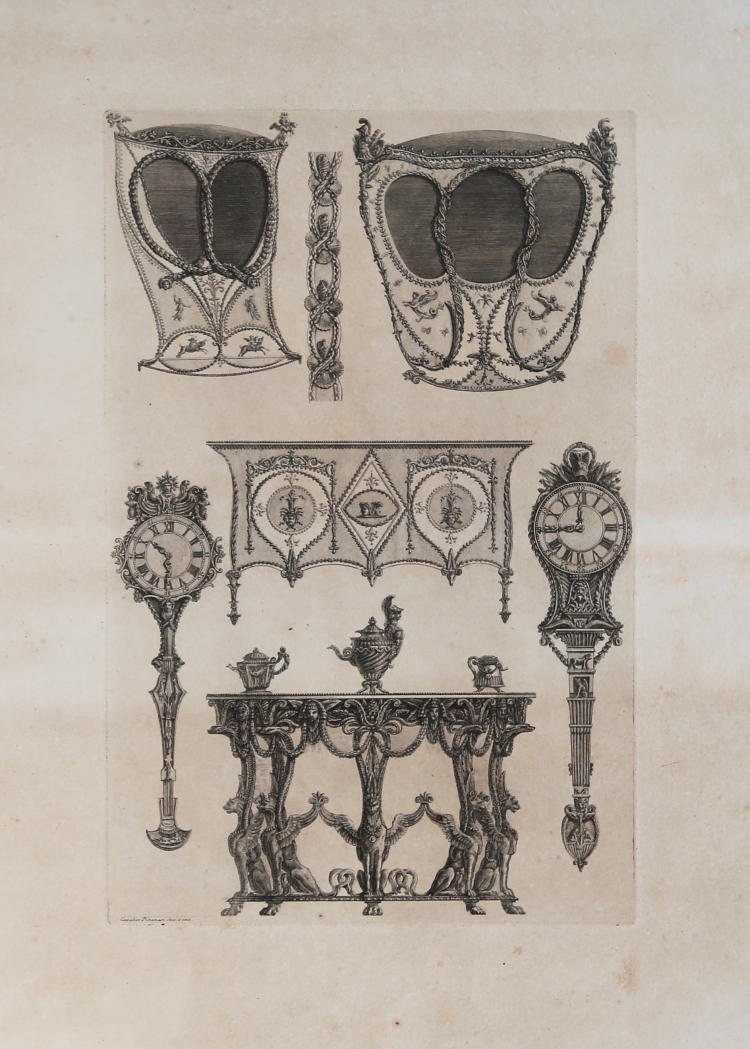




| Reference: | s43627 |
| Author | Giovan Battista PIRANESI |
| Year: | 1769 |
| Measures: | 257 x 382 mm |



| Reference: | s43627 |
| Author | Giovan Battista PIRANESI |
| Year: | 1769 |
| Measures: | 257 x 382 mm |
The plate belongs to the famous series Diverse Maniere d'adornare i cammini ed ogni altra parte degli edifizi desunte dall'architettura Egizia, Etrusca, e Greca con un Ragionamento Apologetico in defesa dell'Architettura Egizia, e Toscana, opera del Cavaliere Giambattista Piranesi Architetto (Diverse Ways of ornamenting chimneypieces and all other parts of houses taken from Egyptian, Etruscan, and Grecian architecture with an Apologia in defense of the Egyptian and Tuscan architecture, the work of Cavaliere Giambattista Piranesi).
Etching and engraving, signed in plate at bottom. Magnificent proof, impressed in black ink on contemporary laid paper with full margins, in excellent condition. A contemporary Roman edition, printed by Generoso Salomoni in 1769.
Although it is published in 1769, a series of epistles traces its age to a few years earlier, and it is assumed that as early as 1767 a good number of plates were ready. Stylistically, this can undoubtedly be regarded as the height of Piranesi's expressed flair. To define it, however, is a hopeless task; neither baroque, nor neoclassical, nor mannerist, but as simply apprised by Focillon "Piranesi style."
The novelty expressed by the sixty plates that make up the volume turns out to be, leaving aside the intrinsic beauty of the engravings, the fact that one is captivated by their bursting imagination, their immediacy, and by an interweaving of classical nostalgia and baroque memories, being almost aware of entering the hallucinated dreams of an archaeologist. In depicting the fireplaces, furniture, clocks and whatever else expressed in Diverse maniere, Piranesi makes use of a number of ornamental figures that can be divided into two broad categories. The first includes elements from the decorative repertoire of classical antiquity with particular reference to Egyptian antiquity, while the other category is represented by elements from the lexicon of nature, present mainly with specimens of fauna. Piranesi's concepts, expressed in the forms he invented and recreated here, appear disturbing and ambiguous, even contradictory and if you will, precursors of Romanticism. This confirms the theory of many scholars, who regard him as a forerunner of the literary style of the Empire rather than the greatest exponent of neoclassicism.
An engraver, designer, architect, and theorist, he is considered one of the supreme exponents of topographic engraving, although he showed the greatest interest in architecture. Although only a few architectural drawings have been produced, he nevertheless had a great influence, in European Neo-Classicism, through personal contacts with architects, patrons and artists visiting Rome over the course of four decades. His prolific production of etching plates, which combined an extraordinary imagination with an extremely pragmatic knowledge of ancient Roman techniques, initiated a new and lasting perception of antiquity. He was also a designer of structures and stages for festivals, a decorator of interiors and furniture, as well as a restorer. The interaction of this extraordinary combination of activities led him to a high concept of drawing, supported by written essays. The legacy he left, relative to his unique vision of Roman civilization, was an imaginative interpretation and recreation of the past that inspired writers and poets as well as artists and other draftsmen.
Bibliografia
John Wilton-Ely, Giovanni Battista Piranesi: The Complete Etchings, 1994, n. 954; Henry Focillon, Giovanni Battista Piranesi, 1967, n. 920.
Giovan Battista PIRANESI (Mogliano Veneto 1720 - Roma 1778)
|
Italian etcher, engraver, designer, architect, archaeologist and theorist. He is considered one of the supreme exponents of topographical engraving, but his lifelong preoccupation with architecture was fundamental to his art. Although few of his architectural designs were executed, he had a seminal influence on European Neo-classicism through personal contacts with architects, patrons and visiting artists in Rome over the course of nearly four decades. His prolific output of etched plates, which combined remarkable flights of imagination with a strongly practical understanding of ancient Roman technology, fostered a new and lasting perception of antiquity. He was also a designer of festival structures and stage sets, interior decoration and furniture, as well as a restorer of antiquities. The interaction of this rare combination of activities led him to highly original concepts of design, which were advocated in a body of influential theoretical writings. The ultimate legacy of his unique vision of Roman civilization was an imaginative interpretation and re-creation of the past, which inspired writers and poets as much as artists and designers.
|
Giovan Battista PIRANESI (Mogliano Veneto 1720 - Roma 1778)
|
Italian etcher, engraver, designer, architect, archaeologist and theorist. He is considered one of the supreme exponents of topographical engraving, but his lifelong preoccupation with architecture was fundamental to his art. Although few of his architectural designs were executed, he had a seminal influence on European Neo-classicism through personal contacts with architects, patrons and visiting artists in Rome over the course of nearly four decades. His prolific output of etched plates, which combined remarkable flights of imagination with a strongly practical understanding of ancient Roman technology, fostered a new and lasting perception of antiquity. He was also a designer of festival structures and stage sets, interior decoration and furniture, as well as a restorer of antiquities. The interaction of this rare combination of activities led him to highly original concepts of design, which were advocated in a body of influential theoretical writings. The ultimate legacy of his unique vision of Roman civilization was an imaginative interpretation and re-creation of the past, which inspired writers and poets as much as artists and designers.
|